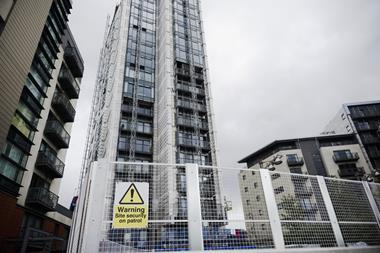In the aftermath of the Grenfell Tower fire, the EWS1 form was created to address fire safety issues, however a lack of professional indemnity insurance for the surveyors that sign off this form has thrown another spanner in the works. Could finding a solution be a key opportunity for brokers and insurers? Insurance Times finds out
There is a lack of professional indemnity insurance (PII) available to cover the surveyors signing off EWS1 forms – a process vital in buying and selling some flats.
This is according to Matt Hodges-Long, chief executive of TrackMyRisks and founder of the Building Safety Register.
He told Insurance Times: “Post-Grenfell, the government and lenders became aware of potentially significant problems with the walls of buildings in terms of them being combustible and unsafe.”
A new EWS1 form was created in 2019 by the Royal Institute of Chartered Surveyors (RICS) in partnership with lenders to address this.

Originally the EWS1 was only supposed to be applied to buildings over 18 metres tall – of which there are 13,000 in the UK, but this changed recently to apply to any buildings with concerns.
Meanwhile, a shortage of qualified surveyors has led to a backlog, with many leaseholders unable to sell or re-mortgage their properties as they are waiting for forms to be signed or remediation work to be carried out.
Hodges-Long believes that finding a solution to the dilemma could be an opportunity for the industry, Insurance Times examines the challenges the industry is facing and what some firms are doing to solve it.
It follows the government establishing a national regulator on 19 January 2021 to ensure homes are built safely – something which the Association of British insurers (ABI) deemed a “positive step”.
Clarity and transparency
The EWS1 (External Wall System) is a process which involves a surveyor identifying combustible elements in the external wall of a building and ascertaining if these can be managed or the building needs remediation work.

RICS launched a consultation, which ran until 25 January on homebuyers on homebuyers being impacted by EWS1 delays with the hope of easing delays.
It said that it was consulting with the ABI, Biba and the International Underwriting Association, as well as welcoming individual insurers and brokers to respond.
The purpose is to set criteria for when an EWS1 is used. A spokesperson for RICS said: “It will also provide clarity and transparency about liabilities assumed by the valuer and those which are not.
”This includes suggested wording for valuers to notify their clients that a change in guidance, or the production of a fire risk assessment in the future, might reveal the needs for works that have not been considered in this valuation.”
One such firm attempting to ease remediation pressure is Birmingham-based Colmore Tang Construction (CTC).
It launched a remediation service for unsafe cladding. It is also working with building owners, managing agents and surveyors to replace dangerous cladding, as well creating an EWS1 hub to educate leaseholders.
It estimates that around 2,000 residential buildings are still enveloped in high-risk combustible cladding. TV personality, Jeremy Clarkson is the latest to be hit with a cladding removal bill of £60k.
Serious teeth
The government has committed £1bn via the building safety fund, however Steve Underwood, chief operating officer at CTC said: “The truth is it is only likely to cover between 5 to 10% of the problem. The real estimate could be closer to £15bn.”
He estimated that that it is likely to cost £13k per flat to fix fire safety issues, and with only some being able to afford this, it will render some properties “effectively worthless”.
Things such as waking watches could be increase costs, where someone patrols the building to ensure it does not catch fire.
“We are seeing evidence that insurance premiums for flats are going up ten-fold, some leaseholders cannot stay where they are [due to safety risks] and they can’t sell their flat as there is no EWS1,” Underwood added.
He said many buildings were not even constructed with the correct standards, “there are bits missing”. And he cited the chair of the Independent Review of Building Regulations and Fire Safety and chair of manufacturing trade body Make UK (formerly EEF) Dame Judith Hackitt’s “golden thread” which proposes a chain of custody for the entire construction and remediation process.
This is to prove buildings are constructed correctly and with appropriate sign offs. It attempts to overcome the two main challenges – a lack of residency engagement and a lack of data.
Hodges-Long founded the Building Safety Register as a means of communication with the regulator, stakeholders, residents, insurers and lenders to combat the data problem, and it holds risk information.

Read more…Leaseholders in high-rise buildings hit with huge insurance premiums post-Grenfell
Not subscribed? Become a subscriber and access our premium content
Meanwhile the Buildings Safety Act (BSA) could enable Hackitt’s “golden thread” to become law later this year. “This changes the game forever, as this was previously looked after by local authorities, now the BSA is going to be policed by the Health and Safety Executive. It’s got serious teeth, as you could [with the new law] go to prison,” Underwood added.
Reasonable skill and care
Fraudulent EWS1 forms caused by the lack of surveyors and PII could pose a dilemma for leaseholders that buy properties in good faith.
Hodges-Long said there is no standard for how the EWS1 is conducted, he said: “From a liability PI perspective, it [uses] reasonable skill and care – [but] it’s not scientific.
”It would be very difficult to defend a liability claim, in its very structure it is probably uninsurable as a risk.”
Meanwhile, speaking about fraudulently signed EWS1 forms, Henry Nava, director at broker Cavendish Munro added that a claim could be filed but not the against the surveyor for a forged signature.
With the EWS1 previously being signed by building inspectors, Nava added: “The belief of insurers is that [surveyors] aren’t experienced enough in this area.
”As soon as [surveyors] sign the form, they owe a duty of care which is where the PII comes in, for the recipient of the form.
”This is a serious responsibility, with possible liability to the building owner, lender, banks, and homeowner if they have issues selling the property or a combustibility claim.
“It’s a minefield for surveyors as they don’t know what is being built.”
He pointed out that it is cheaper for the building contractor to get a surveyor on site, rather than a specialist. Although there are different levels of inspection including a vision inspection and opening the wall to look at the insulation.
“Insurers are really averse to surveyors doing this, and our advice as a broker to clients is don’t sign them,” Nava added.
Hard market
The PII market has hardened significantly across all sectors, according to Laura Hughes general insurance manager at the ABI.
She continued: “For those involved in construction this is a result of a series of previous complex claims, the impact of the Lloyd’s Decile review, the impact of the Grenfell tragedy and the collapse of Carillion, as well as a lack of clarity from government over building regulations which have been deemed by Hackitt as being ‘unfit for purpose’.”
The ABI continues to discuss solutions with government, such as a scheme for certain PII professions to speed up the remediation process.
“The industry has been clear that in the long-term there needs to be fundamental reform of building regulations to provide clarity on roles and responsibilities of those involved,” Hughes added.
What is the EWS1 form?
Created in December 2019 by RICS, the new External Wall System review (EWS1) is signed off by surveyors. It is a process used by valuers, lenders, building owners and fire safety experts in the valuation of high-rise properties, with actual or potentially combustible materials to external wall systems and balconies.
Concerns were raised around completing the EWS1 form and liability that could derive from RICS members that complete the form.
A liability exclusion was applied from May 2020 – all those undertaking EWS1 form work must disclose and discuss with their insurer.
Other key changes made to avoid further contractions in the market and ensure the continued availability and affordability of PII, these are:
• The excess applicable in respect of defence costs, to give insurers greater flexibility to write terms.
• Unlimited aggregate round the clock limit of liability, to provide increased availability
What is RICS 2020 minimum policy wording?
RICS has removed the prescribed fire safety exclusions wording from its minimum policy terms and has temporarily inserted ability for insurers to apply their own fire safety exclusions.
This means firms can talk to brokers to ensure adequate insurance for the work.
But there is an obligation on insurers to provide a product summary under the Insurance Distribution Directive, and the intent and the potential impact of the exclusion needs to be communicated in the product summary.
Why has the PII market in this sector worsened?
Challenges reared their head in the PII market at the end of 2018, RICS suggested three reasons:
• Availability restrictions found in a 2018 Lloyds of London review, highlighted under-pricing of PII and two thirds of syndicates underwriting at a loss
• Economic uncertainty around Brexit, later exacerbated by the Covid-19 pandemic
• Ongoing insurer concerns around fire safety and cladding.
Hosted by comedian and actor Tom Allen, 34 Gold, 23 Silver and 22 Bronze awards were handed out across an amazing 34 categories recognising brilliance and innovation right across the breadth of UK general insurance.




















































No comments yet